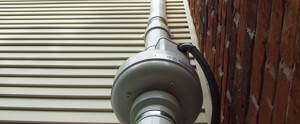Radon Gas in U.S. Classrooms
Health officials warn that thousands of the nation's classrooms are filled with high levels of radioactive radon gas. Chronic exposure could lead to lung cancer, but many school districts aren't doing anything about it.
Watch a video of Dr. David Sanderson, Professor of Medicine Emeritus and learn more about radon.
WEDNESDAY, Feb. 29, 2012 -- Imagine your child is smoking a half a pack of cigarettes per day at school. Inhaling radon, even at the U.S. Environmental Protection Agency's action level, the level at which it recommends schools take action to mitigate radon exposure, yields just about the same result as that half-pack-a-day habit. That's what radon expert Bill Field told the Today show in a new investigative report.
NBC correspondent Jeff Rosen explored radon gas exposure -- a big -- and invisible -- problem facing schools across the country:
Exposure to high levels of radioactive radon gas is the leading cause of lung cancer after smoking, according to the EPA, which links radon to more than 20,000 lung cancer deaths per year. In addition to lung cancer, a recent study published in the European Respiratory Journal linked radon to death from chronic obstructive pulmonary disease (COPD).
"Of all the environmental exposures you get, this is the one that causes the most deaths," Field told the Today show.
But the even bigger problem is that school districts aren't testing their buildings radon levels.
A nationwide survey of radon levels in schools found that nearly one in five has at least one classroom with a short-term radon level above the EPA action level (4 picoCuries per liter), according to the EPA. They round that out to about 70,000 classrooms.
Despite the numbers, the NBC news team noticed a trend when asking schools across the country, specifically ones in radon "hot zones," if they were interested in free radon testing. They're not. Out of 60 schools contacted, 40 declined or failed to respond.
There's no federal regulation requiring radon testing in schools. Many states also require it. According to Rosen's report, only five states currently mandate radon testing in schools.




